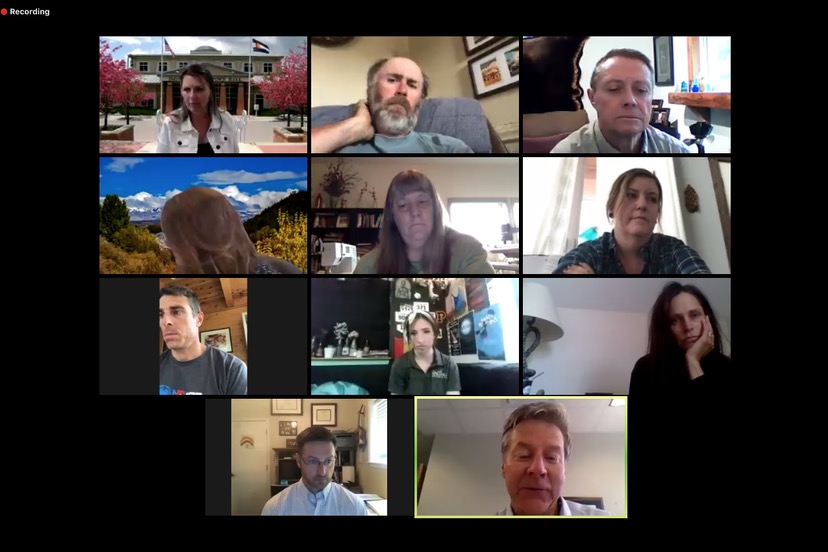Today is the last day for Town voters to drop off their ballots at Town Hall and weigh in on Ballot Measure A. If approved, the measure will give voters some control over Tax Increment Financing schemes proposed by the newly-formed Urban Renewal Authority.
I found the June 18 Town Council ZOOM meeting, last month, to be mildly entertaining. The Council was considering the River Rock Estates subdivision controversy — a controversy that was destined to get me kicked off the Town Planning Commission a few days later. At that ZOOM meeting, the Council discarded a recommendation submitted by a majority of the Town Planning Commission which would have allowed the River Rock Estates subdivision to be built without a single public street.
Instead, the Council specified that the single street planned for the new subdivision would be dedicated to the public.
That decision was something of a surprise to me, the only critic of the River Rock Estates plan serving (at that particular moment in time) on the Planning Commission. I suspect the decision was, likewise, a surprise to Planning Director James Dickhoff, the Town’s most outspoken advocate of private streets in newly-annexed subdivisions.
Mr. Dickhoff had been arguing, for months, that private streets in new neighborhoods would be very much to the Town’s advantage, because the streets would then be maintained by a private homeowners association, and would thus reduce the amount of future work required by the Town Streets Department. Presumably, the money saved by the Town bureaucracy could then go towards more important things — such as, for example, salary increases?
Developer Jack Searle’s construction company, BWD (“Beyond Your Wildest Dreams”) had been working on this particular subdivision proposal for many months: a 15-acre riverfront parcel that would accommodate, in their latest plan, just 10 individual homes. A density of less than one home per acre.
Millionaire homes, in other words… a subdivision totally out of character with the rest of downtown Pagosa Springs. The density in our historical downtown neighborhoods — generally speaking — varies from about 6 dwelling units per acre to about 20 units per acre. Every planning document adopted by the Town Council over the past 10 years has encouraged “increased density” within the historical downtown.
Early in their planning process, BWD had in fact been proposing something more along the lines of 6 units per acre, but the plans got changed. For one thing, the entire property is within the FEMA 100-year flood plain, we’ve been told. Once upon a time, the federal government and American insurance companies had no concerns about folks building homes near a river that flooded once every 100 years — but times have changed, and the proposed River Rock Estates subdivision would’ve needed to spend a fortune on mitigation, to accommodate a typical middle class Pagosa neighborhood on their 15 acre parcel.
When the new plan was brought before the Town Planning Commission last March, my initial concern was that River Rock Estates included no public streets. In fact, when the Planning Commission first looked at the plan, River Rock Estate was a “gated community”.
The Town Land Use and Development Code (LUDC) mentions ‘private streets’ incidentally in a few places, but it also makes several clear statements about some requirements that must be met by new subdivisions seeking approval.
A subdivision must include at least two street rights-of-way, for example.
All parcels created in a subdivision must have frontage on a public street.
All street rights-of-way must be dedicated to the Town.
The River Rock Estates — accessed by one single private street — seemed to violate all three of these laws when the proposal was brought to the Planning Commission on May 26. Town Planning Director James Dickhoff aggressively defended the lack of public streets, however, based mainly on the argument that the Town government would save money if a homeowners association owned and maintained its one platted street, as a private right-of-way.
I found Mr. Dickhoff’s argument to be confusing, because the Planning Commission is legally allowed to approve projects only when they meet the Town LUDC. The LUDC says nothing about ‘saving the Town money’ when approving a new subdivision. In fact, it says exactly the opposite, to anyone who can read standard English.
But we’ve also noted that the English language is wonderfully useful for obscuring the truth and making established laws appear to mean what they were never intended to mean — if that’s your intention. Mr. Dickhoff appears to have considerable facility with the English language, as we will discuss later in this article series.
I had a nice long conversation, a couple of weeks ago, with a colleague who was concerned about my use of the term ‘corruption’ in recent Daily Post editorials, when referring to the actions of certain people at Town Hall. To some people, the term ‘corruption’ is synonymous with bribery and extortion and other high crimes and misdemeanors. As a former member of the Town Planning Commission, I have zero evidence of bribery or illicit financial gain among our Town officials, and I’m happy to report that.
But the term ‘corruption’ can also be applied to non-financial situations — where a lack of integrity or honesty is in evidence, for example. As I explained to my colleague, that’s the sense in which I typically use the word ‘corruption’ here in the Daily Post.
People sometimes act in a corrupt manner to protect their reputations, for example, or to promote a personal agenda that has nothing to do with personal financial gain. Officials have been known to violate the law, either out of ignorance or simply because they want to ‘benefit’ the entire community in some manner — and our adopted laws seem to be standing in the way.
I apply the word ‘corruption’ to any conscious attempt by elected or appointed officials to purposefully evade local or state laws, and I’ve personally witnessed this type of corruption, occasionally… while serving on the Town Planning Commission, and while reporting on the activities of various other boards and commissions in Archuleta County over the past 16 years.
On Monday, in Part One, I discussed the physical corruption of our downtown paved streets — their slow, natural destruction from the effects of sun, weather, and traffic. We can slow the corruption by taking certain preventative actions, but we can’t totally eliminate it.
The same might be said of government corruption. We may be able to slow it down, but we can’t seem to eliminate it.



